The X Button
Awful Great
by Todd Ciolek,

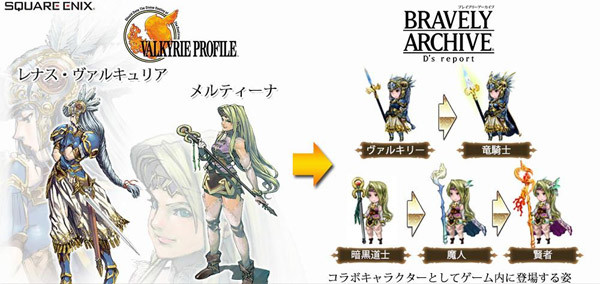
Square Enix's Bravely Archive D's Report is a social-media RPG based on Bravely Default, but it's not above bringing in other games. As the first part of a three-week crossover, Bravely Archive introduced heroine Lenneth Valkyrie and vain sorceress Mystina to the roster of recruitable characters. Yes, it's a cheap and superficial cameo, and we don't even get new illustrations from Kō Yoshinari and/or You Yoshinari. Lenneth and Misty's portraits come from the original Valkyrie Profile.
Yet I will not despair over this. It's a sign that Square Enix remembers Valkyrie Profile and at least considers it worthy of guest starring in a smartphone RPG. It's not Valkyrie Profile 3: Hrist or Valkyrie Kart Racer (yes, I'd buy that), but it's proof that a favorite series of mine still matters to someone in command. As we'll see in other news this week, sometimes that proof is all you need.
NEWS
TALES OF BERSERIA TRIES SOMETHING EVER-SO-SLIGHTLY DIFFERENT
A new Tales game? Inevitable. A new Tales game starring a lone woman? That's a first for the series. The game is Tales of Berseria, and the heroine is a steely-eyed brunette named Velvet. Designed by the talented Mutsumi Inomata, Velvet appears in ripped attire and sporting a resolute quotation about never giving up on some elided quarry. Other characters will join up later, and the world explored will feature snow-covered cities and isles where summer never fades. Hardly a memorable stage, but Bandai Namco has more details to reveal. I hope they give Velvet a last name in Tales tradition, like “Hathaway” or “Valencia.”
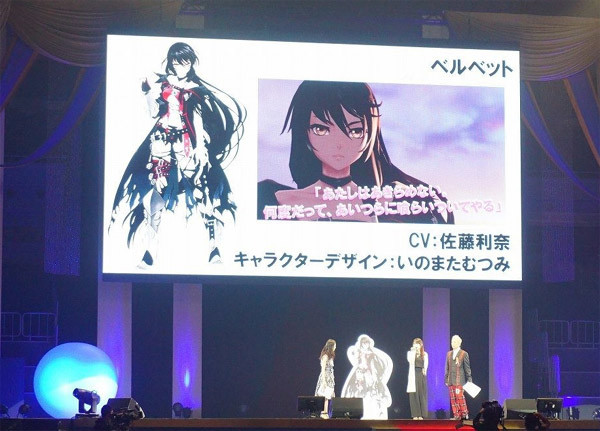
Now, some Tales types may point out that Tales of Xillia gave the player the choice of going through the game as Milla Maxwell, but others will surely counter that Milla technically wasn't a human woman. Perhaps there's some similar, contrived explanation behind Velvet's appearance. It's also notable that Tales of Berseria will show up on the PlayStation 3 as well as the PlayStation 4, as the series continues to span two generations of hardware. Bandai Namco hasn't announced it for any region but Japan at this point, though Berseria is one of the mainline Tales games. Those tend to make it here.
XSEED LAUNCHES LOCALIZATION LINEUP, LASSOES LEGEND
XSEED Games is nothing if not ambitious in the hunt for Japanese titles. The company's 2015 catalog includes the reliable exploitation of Senran Kagura: Estival Versus, which lets loose busty ninja heroines in brawler stages than can now support 10 players on the PlayStation 4 (and four on the Vita). Also aboard is Earth Defense Force 4.1: The Shadow of New Despair, the PlayStation 4 arrival of a series known for clashes between giant, city-wrecking alien insects and desperate human soldiers. D3 brought out the PlayStation 3 and Xbox 360 versions of the game last year, but the PS4 release runs noticeably faster.

The most interesting chunk of new XSEED localization is The Legend of Heroes: Trails of Cold Steel, or rather the two games in that particular sub-series. The Legend of Heroes is notorious even among RPGs for its sheer volume of text, and XSEED took a risk on localizing The Legend of Heroes: Trails in the Sky years ago. The Second Chapter of Trails in the Sky is due out in English this summer, and the Third Chapter lurks somewhere in XSEED's gameplan. Trails of Cold Steel is set on the same continent as Trails in the Sky, but it unfolds at an elite academy in the powerful military nation of Erebonia. Most of the game's characters are students there, and they're caught in a storm of classist divisions, imperial politics, and assassination attempts. It's odd that XSEED leapfrogs the two games in the Crossbell story arc: Trails of Blue and Trails of Zero. Set not long after the Trails in the Sky trilogy, they follow a police investigator in the land of Crossbell. But they're also PSP games, and XSEED and Falcom pegged the Vita-based Cold Steel titles as safer bets. XSEED hopes to have the first chapter out in the fall, while the second goes without a date for now.

XSEED also grabbed a crossover in PoPoLoCrois: A Story of Seasons Fairytale. The 3DS game blends the RPG series (and successful comic) PoPoLoCrois with the crop-tending, animal-raising attractions of the Harvest Moon games. Despite the hero of PoPoLoCrois being a prince and presumably having many serfs to tend his crops, he still handles farm chores. Perhaps it's set after the peasant uprising.
Of course, XSEED can't call it Harvest Moon when Natsume owns the rights to the name, but XSEED can apply the same Story of Seasons nomenclature used for Marvelous' most recent Harvest Moon game in North America. PoPoLoCrois: A Story of Seasons Fairytale is scheduled for a winter release, when Natsume should be releasing their own internally made Harvest Moon: Seeds of Memories. And the curtain lifts on the next major clash of the Harvest Moon Wars.
MEGA MAN REMASTERED JUST IN TIME FOR BATTLE
Meanwhile, the Mega Man Wars remain a series of low-key border skirmishes. Former Mega Man steward Keiji Inafune's Mighty No. 9 has a sturdy September release date, complete with a Signature Edition and a figure of robot hero Beck. It is, of course, Inafune's attempt to reignite the Mega Man series without traipsing into lawsuits. CAPCOM stayed largely quiet on the Mega Man front while Mighty No. 9 went through its Kickstarter funding and development cycle, but the company recently instated a new producer for Mega Man games and commissioned a new Mega Man cartoon from the people who made Ben 10 and Avengers Assemble. And now they have the Mega Man Legacy Collection.

The Mega Man Legacy Collection brings the original six NES games to the Xbox One, PlayStation 4, and PC, and it does so with a fancy 1080p rendition and plenty of extras. Original sketches and other background materials are included, and the game's database lets you jump to specific boss battles. The Challenge Mode presents new tasks in the tradition of NES Remix, and the developers at Digital Eclipse promise other extras that they just can't discuss yet. I hope the Challenges use some of the enemies cut from the games—like this adorable robot seal from Mega Man 4. I bet it floats on its back and throws explosives!
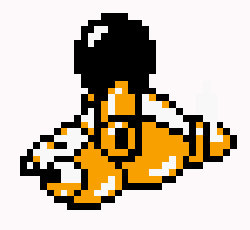
This new anthology sounds unnecessary on the surface. The Mega Man Anniversary Collection came out for the PlayStation 2 and Xbox (and Gamecube, if you want awkward controls), and it has the first eight Mega Man games and the two Power Battles arcade titles. You can find it new even today for under $15, and anyone interested in Mega Man design materials can nab Udon's huge MM25 artbook. It's also odd that the press release evokes the Criterion Collection in its vows of fidelity. Criterion releases aim for the best possible preservation, but they also concern themselves with lavish packaging. Between the restrained artwork and the booklets full of essays about the talking fox in Antichrist, Criterions are for people who want something nice on the shelf. The Mega Man Legacy Collection is just a digital release. For now.
Yet the important thing is that CAPCOM still likes Mega Man at least enough to launch token competition for Mighty No. 9. Developer Digital Eclipse also sounds intlauded preserving other games in high quality, even if their central branch, Other Ocean Interactive, is reeling from an initially flawed PlayStation 4 port of Ultra Street Fighter IV. I'll have tastefully packaged, extensively lauded box sets of Grim Fandango, Valkyrie Profile, and Wurm: Journey to the Center of the Earth, if you please.
THE BEST KIND OF BAD
There's a lot of talk about Fallout 4, the newest in that esteemed line of post-apocalyptic RPGs. Some even say it'll steal the upcoming E3. Well, I don't need any Fallout 4, and neither does anyone else. Because we can play BloodStorm instead!
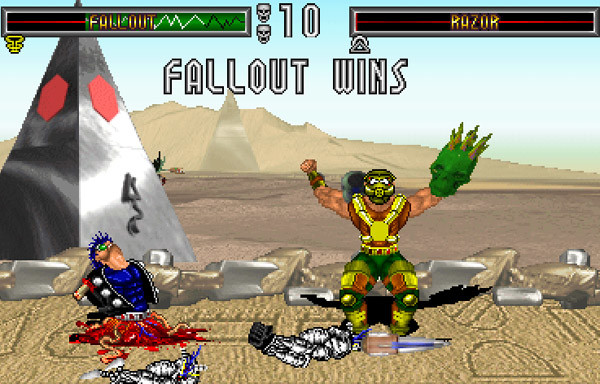
Many will tell you that BloodStorm is a tasteless and shoddy fighting game from 1994. But look! It has a guy named Fallout, years before that RPG series started! And it has bleak, barren landscapes with humorous names like the “Obsel Desert”! And it's so violent that you can hack off each other's limbs and disembowel your opponents, who sometimes keep fighting even when they're just heads and torsos! Isn't that what you want out of Fallout 4? Comedy and violence?
Yes, BloodStorm is a terrible game, and I harbor no doubts that Fallout 4 will be better simply for existing. All bluster aside, however, a BloodStorm sequel or remake would interest me more than any Fallout game.
That's because BloodStorm, due to a mixture of misplaced nostalgia and fumbled invention, is one of my favorite awful games. It's distasteful at every turn and has a cast of characters to fill any lousy bargain-bin superhero comic, but the designers threw in some novel ideas for a mid-1990s arcade fighter: passwords, hidden levels, and powers acquired from defeated foes. It's still a bad game, of course.
Everyone has their favorite miserable masterpieces. They're so bad they're good. They're ironically great or guilty pleasures or just stupid fun. No medium is immune, and today it's hard to find a book, movie, video game, or album uniformly reviled. From Lou Reed's Metal Machine Music to all three animated Disney-ripoff movies about the Titanic (yes, three), someone will enjoy and possibly even defend it. The video-game crowd is no different. Some even adopt the Japanese nerd neologism for their trashy fascination: kuso-ge (“shit game”). It's often reserved for those especially dreadful games that somehow deserve to be remembered, analyzed, and perhaps even celebrated.
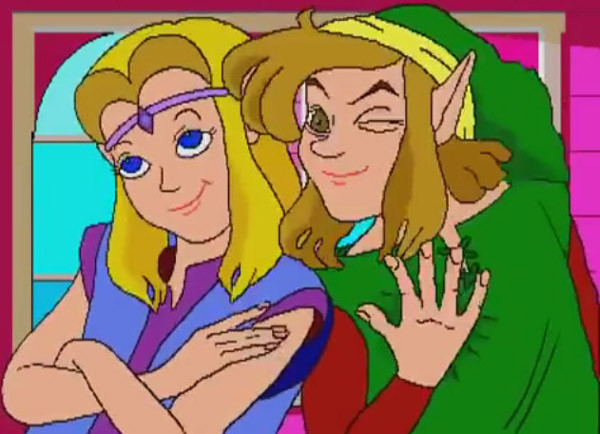
Bad video games play out their horrors in ways that other mediums dodge. A lousy movie or TV show might fill an evening spent with friends, pizza, and improvised mockery. A lousy game demands more time, requires more repetition, and usually isn't any fun to watch in its entirety. So instead we resort to skimming through the terrible games on YouTube. There we can enjoy the bizarrely over-animated cutscenes from The Legend of Zelda's CD-i games or the kissing scene from Sonic the Hedgehog's 2006 outing, which was rampantly derided even by the standards of modern Sonic games. Most of the viewers stick to superficial appreciation. They won't track down a CD-i system, even if some argue that Link: The Faces of Evil and Zelda: The Wand of Gamelon aren't so bad in gameplay. And few look at the cutscenes from the notorious Phoenix Games and Dingo Pictures matchup and decide that they have to own Animal Soccer World or Dinosaur Adventure. They'll turn it into a meme, but they don't need to play it.
Then again, some games will draw players in no matter what. The 1987 Famicom RPG Hoshi wo Miru Hito is a legend among kusoge, a Dragon Quest imitation where psychic children search for invisible towns. Between the slow walking pace and the battle system that can't display all of the characters' hit points, it's hard to imagine anyone playing through the game today. But someone apparently has. In 2004, Japanese fans released a PC remake of Hoshi wo Miru Hito under the name Stargazer.

Other games thrive on both kinds of attention. Bokosuka Wars isn't so bad when compared to other RPGs of 1983, when the genre barely existed. It lets players pace around a level, summon an army, and fight battles without cumbersome menus. But it's also exceptionally primitive, tough, and boring to watch. Most of its modern following seized upon Bokosuka's game-over screen and its “WOW! You lose!” proclamation, but some see more than a relic. Pygmy Studio just announced a PlayStation 4 remake of the game.
Indeed, the best bad games fumble bold and interesting concepts. Sony's Lifeline experimented with voice controls on the PlayStation 2, requiring players to guide a waitress through a monster-infested space station only by speaking to her through a headset. It's a marvel of frustration. Artdink's Tail of the Sun is a caveman simulator that's deliberately inconvenient, as your Neolithic hero is clumsy and prone to sleeping at inopportune times. Yet there's nothing quite like it. More recently, Katamari Damacy creator Keita Takahashi introduced Noby Noby Boy, a game about little more than an elastic protagonist eating and stretching himself. Critics and fans remain divided on whether it's a boring waste or an oddball charmer.
Oddities gave Hidetake “Swery65” Suehiro much of his reputation. Fans didn't congeal around Deadly Premonition, his 2010 survival-horror outing, because of the crude gameplay. They came for the game's open-world attractions, staged with goofy pastimes and eccentric townsfolk instead of Grand Theft Auto rampages, and for the storyline's mixture of baldfaced Twin Peaks imitation and weird, rural murder mysteries. There's rampant debate over whether Deadly Premonition is a bad game turned brilliant or just a brilliant game without ironic qualifications, and one can hatch the same argument about Swery65's D4: Dark Dreams Don't Die (which you'll see reviewed on ANN shortly). If nothing else, both games seem far too sure of themselves to evoke the unintentional nightmares of kusoge.

Indeed, the concept of kusoge raises the question of just what makes a game fun. If you get a momentary laugh from an old Sega CD game that confuses grainy Scottie Pippen video clips for gameplay, it's not a wasted experience. If you find mindless joy in Castlevania: Judgment by flailing away at the controls, gawking at the cornball dialogue and gaudy Takeshi Obata characters, and taking in the legitimately good music, then the game succeeds in some way. It's only the truly mediocre, the mushy and sapless stuff, that disappoints us. A game can be bad as long as it's not boring.
Half the fun is deciding just where a bad game goes good—and arguing over it. Is CAPCOM's P.N.03, which the company threw together as a desperate moneymaker, a bumbling flop or an underrated rhythm-shooter? Was the wearyingly hard Famicom side-scroller Atlantis no Nazo ahead of its time with its inscrutable warp zones? Are Kasumi Ninja and Daikatana and Dirge of Cerberus: Final Fantasy VII really that bad? Dive into a bad game, and you might find it more intriguing than a good one. Even if you hate it.
Just be nice to Wurm: Journey to the Center of the Earth. It's not great, but I sorta like it, y'know?
NEXT WEEK'S RELEASES
New arrivals will be scant next week, but you can try out Lucas in Super Smash Bros. on the 3DS and Wii U. The little tyke from Mother 3 may not seem a major release now, but just wait until his Amiibo comes out in the distant future. If the figure of Ness from Earthbound is any indication, there'll be riots.
discuss this in the forum (28 posts) |
this article has been modified since it was originally posted; see change history